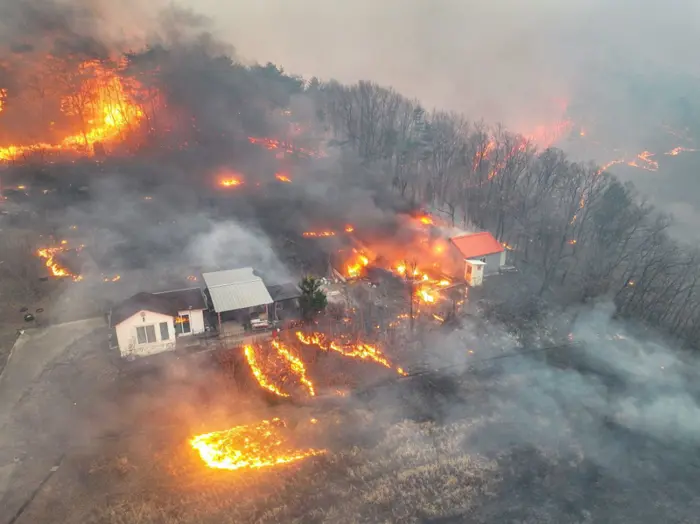SEOUL– A series of devastating wildfires have ravaged southeastern South Korea over the past several days, burning nearly 15,000 hectares of woodland and causing widespread destruction. The fires have resulted in 15 casualties, including four fatalities, while displacing more than 3,300 residents. Authorities are working tirelessly to contain the fires, but strong winds and dry conditions are hindering their efforts.
Extent of the Damage
According to Acting Interior Minister Ko Ki-dong, the wildfires have scorched approximately 14,694 hectares of land across multiple regions, including:
- Sancheong, Hadong, and Gimhae (South Gyeongsang Province)
- Uiseong (North Gyeongsang Province)
- Ulju district in Ulsan
The government has mobilized a massive response, deploying 110 helicopters and 6,700 personnel on Tuesday to combat the fires. Despite these efforts, the firefighting teams have struggled due to adverse weather conditions, which continue to fuel the blazes.
Firefighting Efforts & Challenges
As of 7 AM Tuesday, authorities reported that an average of 88 percent of the fires had been contained. However, efforts are ongoing to prevent further spread, particularly toward residential areas. The government has implemented the following measures:
- Blocking roads to prevent civilian casualties.
- Evacuating residents in high-risk areas.
- Deploying additional emergency services to mitigate damage.
However, strong winds, unseasonably dry weather, and difficult terrain have made containment operations increasingly challenging. The fires, which began due to a combination of human activity and environmental factors, continue to threaten local communities.
Impact on Local Communities
The wildfires have had a devastating impact on communities in the affected regions. Local governments are working to provide shelter, food, and medical assistance to those displaced. Over 3,300 residents have been forced to evacuate their homes, with many seeking temporary refuge in government-designated shelters.
Causes of the Wildfires
Ko noted that South Korea has recorded 234 forest fires nationwide in 2025. The primary causes of these fires include:
- Accidental fires by mountain visitors – Carelessness, such as discarded cigarette butts, has been a leading cause.
- Burning of agricultural byproducts – Farmers often set controlled fires to clear fields, which can spread uncontrollably.
- Improper waste disposal – The burning of trash and other waste materials has contributed to multiple fire outbreaks.
Authorities are urging the public to exercise extreme caution when engaging in activities that could ignite fires.
Government Response & Preventive Measures
To curb further fire outbreaks and improve emergency response, the South Korean government has announced several measures:
- Increased surveillance in high-risk forest areas.
- Stricter penalties for individuals found responsible for starting fires.
- Expansion of firefighting resources, including additional helicopters and rapid response teams.
- Public awareness campaigns to educate citizens about fire safety.
Additionally, efforts are being made to introduce stricter land management regulations to reduce the risk of future wildfires.
Environmental & Economic Impact
The wildfires pose significant environmental and economic threats, including:
- Deforestation – The destruction of nearly 15,000 hectares of woodland will have long-term ecological consequences.
- Air pollution – Smoke and particulate matter from the fires have worsened air quality, affecting public health.
- Economic losses – Damage to infrastructure, agricultural land, and tourism-related businesses is expected to cost millions.
Climate experts warn that rising global temperatures and prolonged dry spells may increase the frequency and intensity of wildfires in South Korea.
International Support & Collaboration
Given the scale of destruction, South Korea is also coordinating with international agencies for potential assistance. Countries with advanced firefighting technology, such as the United States, Canada, and Australia, have expressed their willingness to share expertise and resources.
Conclusion
The 2025 South Korea wildfires serve as a stark reminder of the devastating impact of forest fires. While emergency response teams continue to battle the flames, authorities are focusing on long-term strategies to prevent future disasters. Public cooperation and adherence to fire safety guidelines will be crucial in mitigating risks moving forward.
Stay Updated
For the latest updates on the South Korea wildfires and emergency response efforts, stay tuned to our news platform. If you are in an affected area, follow local government advisories and take necessary precautions.
YAllA TV – www.yallatv.ae





